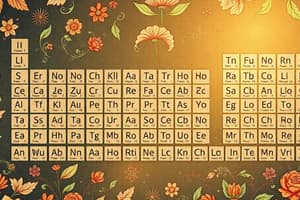Podcast
Questions and Answers
What is the main role of neutrons in the nucleus?
What is the main role of neutrons in the nucleus?
- They provide a positive charge.
- They help keep protons together. (correct)
- They define the atomic number.
- They determine the element's identity.
Which statement about atomic number is true?
Which statement about atomic number is true?
- It represents the average mass of an element.
- It changes with the number of neutrons.
- It indicates the number of protons in an atom. (correct)
- It can vary between isotopes of the same element.
Which of the following correctly explains the concept of isotopes?
Which of the following correctly explains the concept of isotopes?
- Isotopes vary in their atomic number.
- Isotopes consist of different elements.
- Isotopes have the same number of neutrons.
- Isotopes have the same atomic number but different mass numbers. (correct)
What does the atomic mass of an element reflect?
What does the atomic mass of an element reflect?
How does the mass of an electron compare to protons and neutrons?
How does the mass of an electron compare to protons and neutrons?
What is the charge of a proton?
What is the charge of a proton?
Which of the following details does the periodic table provide?
Which of the following details does the periodic table provide?
What role do electrons play relative to the nucleus?
What role do electrons play relative to the nucleus?
Flashcards
Atomic Number
Atomic Number
The number of protons in an atom, which determines the element.
Proton
Proton
Positively charged particle found in the atom's nucleus.
Neutron
Neutron
Neutral particle found in the atom's nucleus, roughly same size as a proton.
Electron
Electron
Signup and view all the flashcards
Atomic Mass
Atomic Mass
Signup and view all the flashcards
Isotope
Isotope
Signup and view all the flashcards
Mass Number
Mass Number
Signup and view all the flashcards
Nucleus
Nucleus
Signup and view all the flashcards
Study Notes
Atomic Structure and the Periodic Table
- The periodic table categorizes elements, including metals, nonmetals, and metalloids (semi-metals).
- The atomic number, located on the periodic table, represents the number of protons in an atom's nucleus.
- Atoms are composed of protons, neutrons, and electrons.
- Protons have a positive charge and are located in the nucleus.
- Neutrons have no charge and are also located in the nucleus.
- Electrons have a negative charge and orbit the nucleus. Electrons are much less massive than protons or neutrons.
Atomic Theory and the Nucleus
- Einstein's work contributed to the understanding of atoms.
- Brownian motion, observed movement of particles, provides evidence for the existence of atoms.
- The number of protons uniquely defines an element.
Properties of Atomic Components
- The nucleus contains protons and neutrons and is generally stable.
- Electrons interact chemically.
- A specific number of neutrons are required for a stable nucleus, affecting the relative atomic mass of an element.
- Isotopes are versions of an element with different numbers of neutrons.
- Atomic mass is the average mass of all isotopes of an element. This affects relative mass.
- Mass numbers differ from atomic mass and represent the total number of protons and neutrons.
- Atomic number is the number of protons.
Studying That Suits You
Use AI to generate personalized quizzes and flashcards to suit your learning preferences.




